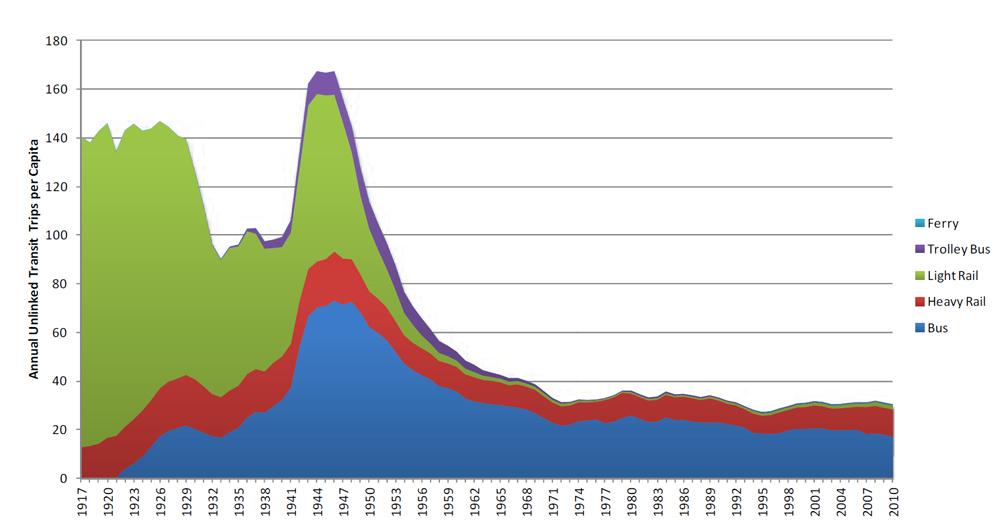The principle
of equilibrium assignment suggests that it is unlikely that congestion will
change much on the corridor. If BRT successfully reduces automobile congestion
on the corridor, travel will be faster in that corridor, and Down’s ‘triple
convergence’[1]
from alternate routes, times and modes will occur. In that context, the amount
of congestion experienced by automobile drivers on the BRT corridor is unlikely
to change significantly. However, from a system user perspective, the BRT may
provide substantial benefits by actually reducing the amount of diversion (and
out of direction travel) that is currently occurring. If this is so, it would
be reasonable to expect a drop in volumes along the diversion corridors. It
seems likely that the combination of ITS features and dedicated transit
guideway will serve to increase the overall capacity of the roadway, and that a
drop in traffic volumes on the diversion corridors is a reasonable hypothesis.
However, if
congestion increases, a ‘triple divergence’ to alternate routes, times, and
modes will occur. How much diversion occurs will depend on how attractive the
alternatives are. Assuming no significant addition in roadway capacity on
alternate corridors, diversion to alternate routes will result in a slight
worsening in overall congestion. Diversion to alternate times will make the
‘peak hour’ longer (AKA ‘peak spreading’). Diversion to other modes may or may
not reduce
congestion.
Buses in
general traffic lanes reduce capacity and increase congestion, a phenomenon
well asserted both by the literature and by experience. The core principle of
making transit ‘rapid’ is removing transit vehicles from general traffic lanes.
This serves to both remove the effect of their operations on automobile
traffic, and remove the effect of automobile congestion on transit vehicles.
As a thought
experiment, assume the BRT is very attractive (in terms of time or cost), and
attracts a large number of riders. This reduces automobile congestion along the
alignment, making it faster. Drivers diverge from other modes and other routes,
and the corridor becomes congested again. But only for automobiles--due to
exclusive guideway, the BRT is less affected, and remains an attractive
alternative. For drivers on the BRT corridor, there is no net benefit. For
transportation system users, there are two classes of beneficiaries: BRT
riders, and drivers on the diversion corridors.
A caveat to the
benefits to drivers: The benefits to drivers on the alternate routes is going
to get ‘lost in the noise’. They will be dispersed over a large number of
roads, and reflected in small changes in the duration of peak periods, or in
minor traffic volumes in a large number of roads. Provo-Orem is a rapidly
growing metropolitan area, with substantial development taking place both north
and south of the study area. Any minor advantage from the BRT to drivers will
be rapidly eroded by additional land use changes.
A caveat to the
benefits for riders: ‘rapid transit’ implies exclusive guideway; most BRT
systems are only ‘semi-rapid’. While provided with transit signal priority,
time separation (at intersections) provides a reasonable analogue to rapid
transit conditions. However, the Provo-Orem BRT has only 51% exclusive
guideway. Where the BRT lacks dedicated guideway, it will be exposed to the
effects of congestion. In ideal circumstances, this guideway will be placed in
the most effective location; where congestion is most intense. Congestion also
tends to be greatest near intersections. Thus, roadways tend to be widest at
intersections, where the road shoulder is used to provide turn lanes. Many
worthwhile BRT projects have been subjected to the ‘death of a thousand cuts’;
minor sacrifices made in the name of preserving automobile capacity (or
worse:maintaining on-street parking).
However, given
the number of routes that the also service parts of the BRT corridor[2],
it is unlikely that all of the delay induced by local buses will be eliminated. In the context,
it seems likely that the corridor will stay at a very similar level of
congestion.


